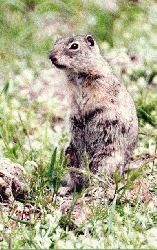Seems like everybody is out to get the sage rat
Published 12:00 am Friday, April 23, 2004

- Is somebody shooting at me? (Baker City Herald/S. John Collins).
By JAYSON JACOBY
Trending
Of the Baker City Herald
If you were a sage rat and feel fortunate that you are not you would understand.
You would understand why sage rats live underground.
Trending
Why they hibernate in summer and fall as well as in winter.
And why, during the brief period when they’re awake, they rarely scurry more than 200 feet from their burrows.
Many things want to kill sage rats.
And most of them succeed.
Hawks.
Coyotes.
Kids wielding .22 rifles.
Kids’ parents, also wielding .22 rifles.
Shoot, even sage rats kill sage rats.
During the late winter breeding season, males will fight, sometimes to the death, to gain the favors of a fertile female, who must feel awfully disappointed when the spectacle ends with a pair of eviscerated suitors at her feet, neither capable of fulfilling its mission.
Even baby sage rats, ensconced in the apparent safety of a cozy underground cavern, may be brutally betrayed, and possibly by their own parents.
According to biologist Jill Mateo, adult sage rats of both genders occasionally display, as Mateo puts it, andquot;infanticidalandquot; tendencies toward their offspring.
And you thought getting grounded was harsh punishment.
Mateo’s research shows that about half of each spring’s crop of newborn sage rats either ends up in some predator’s stomach or is felled by gunfire by autumn. And about 60 percent of those survivors die of starvation during their winter hibernation apparently because they’re so busy dodging bullets and badgers (and, perhaps, mom and dad) that they can’t eat enough seeds, grass and insects to last through winter.
Demeaned and defamed
So disrespected is the sage rat that hardly anyone, besides biologists like Mateo, even addresses the half-pound creatures in proper fashion.
Though they’re saddled with the rat label, like some flea-infested big city sewer rat, the sage rat isn’t a rat at all.
It’s a squirrel.
A Belding’s ground squirrel, to be precise.
And despite being targeted by weapons ranging from an eagle’s talons to a badger’s claws to a .22 bullet, these squirrels not only survive in Baker County and much of the rest of Eastern Oregon, they thrive.
Like most small rodents their populations are cyclical. Sage rats are susceptible to a variety of diseases that can decimate their ranks in a single year, but because they reproduce almost as rapidly, sage rats can quickly repopulate an area.
In Northeastern Oregon, at least, sage rats seem to be on the rising section of the population curve.
andquot;They’re very abundant right now,andquot; said Vic Coggins, a wildlife biologist at the Oregon Department of Fish and Wildlife’s (ODFW) Enterprise office.
So abundant, in fact, that it’s unlikely any other species will provoke so many hunters into firing so many rounds of ammunition this year.
andquot;It’s a little more interesting than shooting at paper targets,andquot; said Charlie Brinton of Baker City.
Brinton is president of the Oregon Hunters Association’s Baker County chapter.
He is also a frequent shooter of sage rats.
andquot;If you’re in a field and there’s a lot of rats, you can go through 500 (.22 caliber) shells in a day,andquot; he said. andquot;That’s not uncommon.andquot;
Sage rat shooting is an ideal family sport, Brinton said. Unlike deer and elk hunting, it rarely requires a long, hard hike through steep and rough country.
Brinton said his five-year-old daughter, Ashlee, is andquot;just getting startedandquot; as a sage rat shooter.
And even his 2-year-old son, Brice, likes to tag along, an unloaded BB gun clutched in his tiny fist.
andquot;He just likes to carry it around,andquot; Brinton said.
Sage rats and the rites of spring
Spring is sage rat season.
Although you can legally shoot them at any time of year, rats are most active, and most visible, after the snow melts and before grass grows high enough to hide their furry, 10-inch-long bodies.
andquot;This year I heard people were seeing them out running on top of the snow in some places,andquot; Brinton said. andquot;When the sun comes out they come out.andquot;
By mid-summer most sage rats have started their long sleep, which usually continues until late winter.
Many big-game hunters hone their aim by shooting at the little sage rats.
A .22 caliber rifle fitted with a scope is the most popular weapon, Brinton said.
A .22 is light, not very loud, and its kick is as gentle as a kitten’s. Ammunition is cheap, too say $10 to $15 for 500 shells.
The new .17 caliber rifles share most of those attributes, and because they generate muzzle velocities that make .22s seem like slingshots, a .17 caliber has a trajectory that resembles a billiard table. The downside with the .17 caliber is that you’ll shell out more for shells.
Brinton said a smaller number of hunters haul heavier artillery deer- and elk-hunting rifles in calibers such as the 30.06.
A bullet made to take down an 800-pound bull elk carries plenty enough lead to stop a 12-ounce sage rat, of course.
But Brinton said that for some hunters, shooting sage grouse is the best way to sight-in a rifle before the autumn big-game seasons start.
andquot;Some die-hards will bring a shooting bench, and sit in one spot and make long shots all day,andquot; he said.
Shooting sage rats will barely strain the skills of even a modestly talented marksman.
Although sage rats present a tiny target and are capable of scurrying at a respectable speed, they also tend to waste these natural advantages and thus their lives by standing still on the lips of their burrows.
Occasionally a sage rat acts so stupidly that even a cold-hearted hunter might feel a smidgen of pity as the rat, seemingly oblivious to the danger, fails even to flinch when a slightly mis-aimed bullet hits close enough to douse the rat with dirt.
Almost invariably the second bullet (sometimes even the third, if the rat lacks even a shred of intelligence) flies true, leaving the hunter to wonder why four-point bucks can’t be so cooperative.
Rats wreak havoc on farms, ranches
Farmers and ranchers, however, spare no sympathy for sage rats.
The tunnel-digging pests degrade crop fields and pastures, said Buck Buckner, a Baker Valley rancher who’s also an accomplished hunter and certified firearms instructor.
Sage rats eat alfalfa and other crops, and the leftover dirt from their digging buries plants the rats don’t munch.
The dirt mounds also can damage swathers and other equipment, Buckner said.
And wherever sage rats gather, famished badgers soon will follow, Buckner said.
Although badgers can eat a lot of sage rats, they also dig holes both deeper and wider than the sage rats’ modest-sized accommodations.
A badger hole can break a horse’s leg.
andquot;And the rider’s neck, if he’s thrown,andquot; Buckner said.
Given the sage rats’ long list of misdeeds, it’s no wonder many farmers and ranchers welcome rifle-toting visitors during the spring.
Both Brinton and Coggins said they’ve heard of landowners who even bought .22 shells for sage rat shooters.
Brinton reminds hunters to always ask for permission from the property owner first.
It’s a matter of courtesy, of course.
But Brinton said sage rat shooters also need to find out whether there are irrigation pipes or livestock sharing the field or pasture with the rats.
Suffice it to say that no farmer or rancher is willing to swap a few dozen dead sage rats for a pipe with bullet holes or a shot-up calf.
Craig Foster, an ODFW wildlife biologist who works in Lakeview, said that when he was stationed at the agency’s John Day office several years ago, the manager of a ranch near Kimberly actually charged hunters $150 per weekend to shoot sage rats.
The price included lodging and meals, Foster said.
He said a few other landowners have also tried, but with little success, to profit from their proliferation of sage rats.
andquot;The thing is, you could knock on the neighbor’s door and not only won’t he charge you, but he’ll give you bullets,andquot; Foster said. andquot;Most (landowners) are more than happy to allow you to go shoot as many as you want.andquot;









